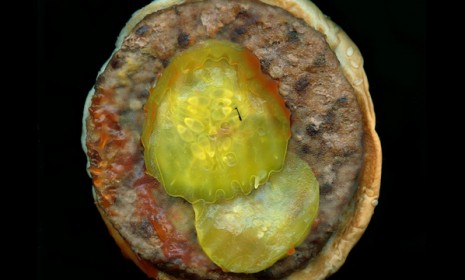The $345,000 burger grown in a petri dish: By the numbers
Can lab-grown meat help meet the global demand for meat?

Lab-grown meat is coming. But growing a burger in a petri dish won't be cheap, at least not at first, says Mark Post, a vascular biologist determined to grow "cultured meat" in his lab. Eventually, though, costs will drop as the process is refined. Then in vitro meat could have a huge economic impact, helping satisfy rising global demand while saving land, water, and energy costs. It could even be a solution to global warming. Here's a look at how the sausage of the future gets made, by the numbers:
$345,000
The estimated cost to produce the first lab-grown burger. Post says he hopes to accomplish the feat within a year, "just to show it's possible."
The Week
Escape your echo chamber. Get the facts behind the news, plus analysis from multiple perspectives.

Sign up for The Week's Free Newsletters
From our morning news briefing to a weekly Good News Newsletter, get the best of The Week delivered directly to your inbox.
From our morning news briefing to a weekly Good News Newsletter, get the best of The Week delivered directly to your inbox.
$4.07
The average cost of a McDonald's Big Mac in the United States as of June 2011, according to The Economist
1
In inches, the length of pale, muscle-like strips Post has been able to grow in petri dishes. Each is a centimeter wide and thin enough to see through.
A free daily email with the biggest news stories of the day – and the best features from TheWeek.com
3,000
The number of these artificial meat strips that will be needed to layer together a burger patty
218 million
In tons, worldwide annual meat production from 1997 to 1999, according to the World Health Organization
376 million
In tons, worldwide annual meat production estimated for the year 2030 — with demand likely being much higher
34.2 million
In 2010, the amount of cattle counted for U.S. commercial slaughter, according to the USDA
26.4 billion
In pounds, the amount of beef consumed in the U.S. in 2010
100
Grams of vegetable protein fed to cattle to produce every 15 grams of edible meat from livestock
50
Percentage of agricultural land currently being used to raise livestock, says Post. "It's simple math. We have to come up with alternatives."
18
Percentage of global greenhouse-gas emissions contributed by the meat industry, according to a report by the U.N. Food and Agriculture Organization
35 to 60
Percent energy lab-grown meat would save compared to traditionally farmed livestock, according to the journal Environmental Science and Technology
80 to 95
Percent greenhouse-gas emissions lab-grown meats would save versus conventionally produced animal meat
98
Percent land lab-grown meats would save versus conventionally produced animal meat
Sources: The Economist, International Business Times, Reuters, USDA
-
 Is Keir Starmer being hoodwinked by China?
Is Keir Starmer being hoodwinked by China?Today's Big Question PM’s attempt to separate politics and security from trade and business is ‘naïve’
-
 A peek inside Europe’s luxury new sleeper bus
A peek inside Europe’s luxury new sleeper busThe Week Recommends Overnight service with stops across Switzerland and the Netherlands promises a comfortable no-fly adventure
-
 Space data centers could be joining the orbit
Space data centers could be joining the orbitUnder the radar The AI revolution is going cosmic